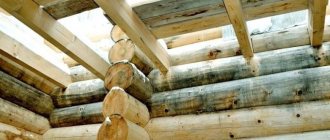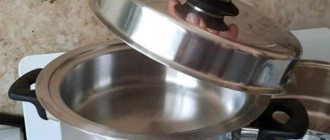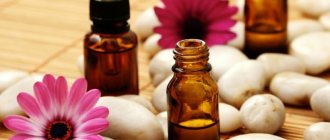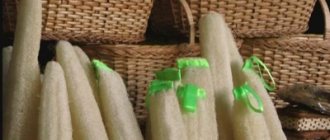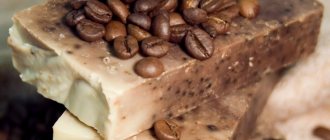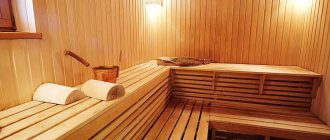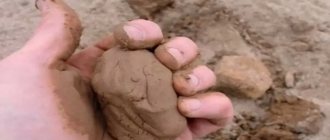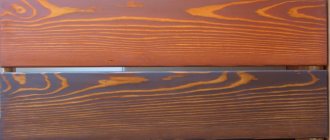Causes of fungus formation
Fungus and mold can develop on any wooden surface, regardless of lumber; even imitation timber and laminated veneer lumber are not immune to damage by microorganisms.
The type of wood also does not matter in this case; fungus can appear on both inexpensive pine and elite oak. A very common reason for the appearance of blue stains is improper transportation and violation of storage conditions of logs and timber. Lumber should be stored in a well-ventilated, dry place. It is advisable that the area is in the shade and that the tree is not exposed to precipitation.
Fungi that contribute to the formation of blue and gray plaque on wood develop very quickly, especially in suitable conditions. Therefore, you need to get rid of mold and mildew as soon as traces of their presence are discovered, especially in the bathhouse. This room creates the most favorable conditions for the proliferation of microorganisms - high temperature and high humidity, which significantly speed up the process.
In the bathhouse there are ideal conditions for the formation of fungus; heat and moisture contribute to the rapid destruction of wooden lining. Therefore, the panels should be protected with special compounds. In addition to the fact that they allow you to whiten the surface, they also prevent the formation of fungus and mold:
- Snegurochka-2 - this composition completely disinfects and bleaches even wood that has darkened over time.
- Supi Saunapesu is a Finnish-made product created for disinfecting and bleaching lining in a steam room.
After processing wooden lining, you need to carefully monitor and care for the surface. After each use, it is necessary to thoroughly ventilate and dry the room and clean it. In winter, you should cool the bathhouse with frosty air.
If you do everything correctly and carefully monitor the premises, then the next major renovation in the bathhouse will not be soon.
Peculiarities of processing lining in the washing compartment and dressing room
Decorative finishes in the wash compartment are constantly exposed to the negative effects of steam and water. Therefore, providing protection with antiseptic compounds is a top priority.
You can cover the lining in the bath with the following preparations (our recommendations):
- “Senezh Sauna” is an antiseptic impregnation to protect wood from damage by fungi, mold and wood-boring insects. It is intended for treating wall and ceiling surfaces, as well as doorways in rooms with high humidity and temperature changes.
- Dulux Celco Sauna is a water-based varnish with good moisture and heat-resistant characteristics. Allowed for use in rooms with a temperature range from 70 to 120 degrees. The varnish is resistant to darkening, has no unpleasant odor, and dries quickly.
- “Snegurochka 2” is a two-component antiseptic composition that prevents the formation of mold and mildew, ensures the sanitation of wood, and helps lighten lining that has darkened due to prolonged contact with water.
To paint the lining and prevent the negative effects of moisture, steam and temperatures, it is necessary to use safe protective compounds for wood. Even a novice craftsman with minimal experience working with painting tools can master the technology of processing wooden surfaces in a bathhouse.
Basic Rules
How to clean soot in a bath? There are certain rules for this. For example, wooden surfaces covered with a layer of soot should not be wetted.
Wood is a hygroscopic material that quickly absorbs moisture. Together with water, everything that has settled on the surface - soot, soot, bodily fluids, etc. - will be absorbed into the structure of wooden elements. Once the dirt is absorbed into the surface of the wood, it will be almost impossible to clean the shelves in the bathhouse, walls, floor or ceiling.
Therefore, when deciding how to clean soot from walls or floors in a bathhouse, you should categorically refuse to use such substances and materials as:
- laundry soap;
- water;
- sponges;
- spray guns.
All of the above products can only be used for final cleaning of wooden surfaces, when the carbon deposits have already been cleaned dry.
All work on cleaning the bathhouse from soot and soot must be carried out using special protective equipment:
- blind safety glasses;
- respirator;
- thick rubber gloves.
All this will help prevent combustion products from entering the respiratory tract.
Is it possible to bleach wood after using Pinotex, firing, or brushing?
Pinotex is an acrylate-based impregnation for wooden surfaces. In addition to the acrylate base, different brands of Pinotex may contain antifungal additives, water repellents and ultraviolet ray filters. There are several shades on sale - from colorless to dark brown. In some cases, the painting result may differ by several shades from the shade stated in the catalogue.
It is easy to correct the color to a darker one: to do this, you need to cover the wood with a darker Pinotex. The opposite situation is more difficult, when you need a lighter shade. Since Pinotex is not a varnish, but an impregnation, it penetrates into the deep layers of wood, from which it is difficult to remove.
A slight lightening can be achieved by removing the top layers of the board by sanding. It is not recommended to use bleaching mixtures. Practice has shown that with this method the wood can lighten unevenly with the formation of unsightly spots.
Brushing is a process in which the softer layers of wood are sanded away. As a result, the surface of the board acquires a texture, in which the natural pattern of annual stripes and rings in places where branches branch off becomes more pronounced. Brushed wood is coated with an impregnation containing substances that prevent fungal growth.
The principle of firing is the same as that of brushing - removing loose layers. The method differs in that instead of abrasive materials, fire is used to burn out the soft layers. As a result, the smooth surface is covered with an exquisite relief of dense wood veins of a darker tone. Boards treated by firing are not bleached; carbon deposits are removed using hard brushes and water.
I hope that the material presented is enough to properly process wooden structures that have lost their visual appeal on their own. The following video will help you understand the above.
Source
Wood bleaching - recommendations and advice from professionals
Before treating wood with bleaching agents, the surface must be sanded well. As a result of sanding, up to 20% of the blue stain is removed. In addition, bleach penetrates and is absorbed into the wood structure better if it is applied to sanded boards.
So, the main recommendations:
- after bleaching, any composition must be washed off with water;
- acid-based bleach is washed off with an aqueous solution of soda;
- You cannot combine different compositions; the surface can only be treated with one product.
- if the wood is severely affected by fungus, it is necessary to treat it with a more concentrated composition.
- bleaching is most effective if it is carried out at a temperature of 18-20 degrees Celsius and at a humidity of about 60%;
- When processing wood inside the house, it is necessary to ensure ventilation of the room, because Almost all formulations contain components that are unsafe for health. If the treatment was carried out in a bathhouse, it is necessary to dry-heat the room twice before taking bath procedures to remove chlorine fumes.
Below you will learn how to whiten a log house after sanding.
The consequence of long-term use of a wooden house is the wood turning blue. The reason for the appearance of blue is certain types of fungus, which forms over time on the surface of an old wooden house, especially in cases where the wooden structure has not been periodically treated with protective agents.
However, a healthy tree can have multi-colored spots if the natural pigment is unevenly distributed. Darkened and unevenly colored wood greatly spoils the appearance of the house; in addition, fungi can cause rot and destruction of the wood structure. An effective way to combat blue stains is to bleach wood.
What means and how to whiten the walls of a wooden house will be discussed in the article.
Preventive action
To prevent the development of fungus before shipping, it is advisable to coat them with transport antiseptics, which protect the wood for 10-15 days. Even despite these measures, blue discoloration (the result of fungal activity) often appears even after treatment. Then the question arises: how to bleach a log?
Here everything is much worse: white mold has been added to the blue, and it must be fought mercilessly: it destroys the structure of the tree. Therefore, it definitely requires treatment with bleach and then a powerful bioprotective impregnation.
To prevent or stop/slow down the development of fungus, it is important to properly store lumber until the construction of the log house begins. It is not always possible to lay a frame straight from the wheels. Even if it was planned this way, in most cases there are hiccups. And an incorrectly folded log is quickly damaged by fungus.
Therefore, immediately make ventilated stacks. They should be located on a dry area of soil, preferably in the shade. But questions of light and shadow are not fundamental. It is much more important to find a dry area.
It is equally advisable to protect the logs from precipitation: install a temporary canopy. At the same time, do not close the sides. In this case, good ventilation is more important than inaccessibility to droplets.
Cleaning walls and ceilings
Solving the problem of how to clean soot in a bathhouse begins with a vacuum cleaner. To do this, you need to walk it on wooden surfaces. Next, you need to carefully sweep away the soot and soot from the walls and ceiling with a broom.
Prepared surfaces must be cleaned with specially impregnated sponges. They are sold in hardware stores. During the manufacturing process, such sponges are impregnated with special compounds that destroy soot and soot.
Sponges get dirty quickly, so you need to purchase several of them at once. You can extend the service life by cutting off the soiled layer of the sponge. When the soot and soot are completely removed, you can clean the surfaces of the walls, floors and ceilings with aqueous solutions of detergents.
Abrasive powders cannot be used in this case. They spoil the structure of wooden surfaces.
To clean hard-to-reach areas, it is better to use a mop with a long handle.
Surfaces are washed 2-3 times. In this case, the water must be changed periodically, adding a new portion of detergent to it.
When the question of how to clean the lining in a bathhouse from soot has been resolved, you need to rinse off the cleaning solution with clean water. For this it is better to use running water. It is better to feed it from a hose under low pressure.
At the end of the process, wipe the washed surfaces dry with a clean soft cloth. You can use an old bath towel. A large amount of moisture or poor thermal insulation may cause the lining to turn black. In this case, the answer to the question of how to clean the lining in a bathhouse will be a grinding machine, but this is if the darkening has affected only the surface layer of wood.
To clean walls lined with clapboard, you will need an angle grinder with a power of no more than 1 kW and a flap wheel with a diameter of 125 mm (grit size no more than 40 units). The lining is sanded in such a way as to remove the darkened layer to a depth of approximately 3 mm.
If the blackness has been absorbed to a great depth, the lining can be painted. But not in the steam room. No paint coatings are used here at all. You can replace the darkened lining partially or completely with new material.
We suggest you read: How to attach penoplex to a brick wall
Impregnating compositions for bleaching darkened wood, prepared on the basis of chlorine, are not recommended, since the carbon particles that determine the dark color of the walls are practically not discolored by compositions containing active chlorine.
Over time, unaesthetic dark spots appear on the surface of the bathhouse logs on the outside, which spoil the appearance of the structure.
Liquid bleach can be used to remove such stains. It is applied to a surface that has been previously cleaned of dust and dirt. For work, brushes with artificial bristles are used, which need to be changed periodically, because the cleaning composition corrodes them. Before applying, you need to test its effect in an inconspicuous place.
The product is carefully distributed over the entire surface and left for some time according to the instructions on the package. Then you need to rinse the surface with running water from a hose. Next, the bathhouse is ventilated to remove the pungent odor of bleaching agents.
If the blackening penetrates to a greater depth, the logs can be sanded with a grinder. In this case, safety precautions must be observed.
To clean the shelves in the bathhouse, you can use a car wash. Water is supplied through it mixed with air and under high pressure. This helps to easily remove the top layer from darkened wood. In this way you can also clean the floors, walls and even the ceiling in the bathhouse.
To thoroughly clean the floor in the bathhouse, you can use a plane, preferably with an electric drive. First, the floorboards must be carefully removed and thoroughly dried, then processed with a plane. In this case, the top layer of wood on each side is removed to a depth of 5 to 10 mm.
This type of cleaning often results in sharp edges on the floorboards. They can be removed with a belt or vibratory sander. You can also use these devices to clean up darkened wood instead of using a plane.
If the darkened layer of wood is thin, you can simply sand the surfaces with sandpaper. An electric drill with a special attachment will help make the process easier. You can only work with completely dry surfaces.
This method will help you get into corners and other hard-to-reach places. There is no need to remove individual elements.
This treatment is often recommended when answering the question of how to clean aspen seats and other wooden surfaces in a bathhouse. After processing and sanding with sandpaper, they will not only be clean, but also absolutely smooth.
Sequencing
Specific actions depend on what stage the construction of your bathhouse (house) is at.
Before construction starts
If the logs have just been delivered, and some are already affected by blue staining, they need to be treated with bleach before being placed in the log house. If only part of the materials is affected and there are absolutely clean logs or beams, then it is better to coat only the affected ones, leaving the rest as is.
After treatment with bleach, the surface is treated with an antiseptic (after drying the bleach). Don't forget to process the bowls as well as the ends.
Just don’t get it mixed up: after bleaching, treat not with a finishing film-forming composition, but with a water-based or solvent-based antiseptic (they are not very popular because they are not environmentally friendly). Precisely an antiseptic, preferably of deep penetration, which does not form a film.
If the log did not need bleaching, it is not coated with an antiseptic. The fact is that after drying you will have to sand the frame. And wood treated with an antiseptic does not sand well. If the log is clean, and there is a season ahead with minimal precipitation or low temperatures, then without moisture or heat, fungi will not develop without any treatment.
After drying, the logs or beams are sanded. There is a high probability that all the blue will be removed
After installing the log house, it is covered with a roof and in this state is left to dry out/shrink. There is one point: during this period, you should not cover the cut window and door openings with film. You can fill it with boards, but with cracks so that moisture can escape freely. You can also use vapor-permeable films (if the film has one-sided conductivity, do not confuse which side should be nailed - the rough side facing the street). If the openings are closed tightly, there is a high chance of getting mold or white fungus in addition to the blue. Therefore, take care of ventilation.
Blue of dried logs (timber)
After drying and shrinking, it’s time to polish the frame . This is where the need for bleaching may arise again. If there is blueness, bleach, if not, you don’t need to. Then comes the grinding of the frame. In the process, many minor lesions that the bleach did not remove can be removed mechanically: you will still have to remove the darkened layer of wood, so this may also remove fungus-affected wood.
After the first pass with a grinding machine, the condition of the treated logs is assessed. If there are dark spots, they are treated with bleach again. Only this time you need to act carefully: light spots on wood are no less pleasing than dark ones. Therefore, the sequence is as follows: first, generously moisten the darkened area, and then rub it with a brush, “blurring” the boundaries of the treated area. After the bleach has dried, the frame is sanded with a fine-grain abrasive until smooth.
In case of deep damage, simply sanding is not enough: no one will remove two or three centimeters of wood
Then, they are immediately coated with an antiseptic, fire retardant and finishing composition (for example, Senezh wood protection compositions). You can use combined products, or you can use three different ones. You just need to select compatible compounds.
If it works, take all the products from the same brand: there will be no compatibility problems. If this does not work out, before purchasing a large batch, buy the selected products in small packaging. Use them on some unnecessary piece of wood (cover it with a layer of the last compound applied to the walls) and try how they behave in combination. It is necessary that they do not react and do not stain the wood. For example, some antiseptics in combination with chlorine give a pink color. Also check whether the product lays evenly, does not roll down and how well it is absorbed.
Using the same test, determine how much you like the selected topcoat tone, and how many layers you will need to apply to achieve the desired result.
Before buying a large batch of bleach, antiseptic and paint, test them all on an unnecessary (or invisible) piece of wood
Unfortunately, it is impossible to determine the effectiveness of the protection. Unless you can see if the water will be repelled. After the topcoat has dried, spray the board and see what happens. Drops should roll off but not be absorbed.
What are the dangers of self-processing wood?
Wood can be bleached with bleach. Before applying the product, it is necessary to remove the resin from the tree; to do this, the surface is treated with soda ash. Next, you need to dilute bleach with water in the following proportion: 2 kg of dry matter per bucket of liquid. Add 250 g of soda to the diluted solution, mix everything and let stand for a while.
The product is applied with a brush or roller, and 5 minutes after treatment the surface is wiped with acetic acid. After about fifteen minutes, the wood should lighten. If the wood is not lightened enough, the procedure can be repeated.
Another chlorine-based bleach is bleach. It is especially effective for outdoor use. The wood is generously moistened with the liquid and then rubbed well into the surface. When using white, you must protect your eyes and hands from contact with the product.
Home craftsmen, doing bleaching with their own hands, have very little idea of how complicated and dangerous this process is. All bleaching compounds are based on poisonous and toxic substances, which, if used incorrectly, can damage the surface and cause irreparable harm to health.
Non-professionals often incorrectly calculate the concentration of the product, violate the proportions, and do not include the necessary components in the composition, which negatively affects the wood.
It is necessary to strictly follow the technology of applying and rinsing off the product. The slightest violation of the technological process can lead to very sad consequences.
To avoid mistakes and prevent negative consequences, it is necessary to entrust bleaching of a wooden surface to specialists.
We employ professional craftsmen who know exactly the technology of wood bleaching and have successfully carried out this operation more than once.
If the walls of your wooden house are corroded by fungus, darkened and acquired a blue tint, contact our company. We will efficiently and quickly carry out all the necessary measures to whiten and renovate your home, which will again regain its lost beauty.
On the “Contacts” page you will find all our coordinates where you can contact us in a way convenient for you.
Calculate the cost of painting and insulating your home right now
Select types of work:
Select materials:
Do you have accurate measurements of the house?
By clicking on the button, you consent to the processing of personal data
The troika and the bathhouse are genuine national symbols. With a difficulty level of three, but building a bathhouse is a sacred task. On the estate, in the village house of grandparents, in the country, where possible. The construction itself will add optimism, energy, and health.
And a ready-made bathhouse - with a steam room, a broom, a heater, and a swimming pool - will replace clinics along with pharmacies. Work for your own pleasure, for your own health, and not for the benefit of pharmaceutical companies. The material is only wood, as it has been for hundreds of years. After all, they lived in the forests.
- Preparation
- Impregnation
- Process
- Conclusion
The best option is to cover the interior with clapboard. Log house? Amazing! Walls made of brick, shell rock, stone?
And in this case, wooden lining will improve the interior, especially if the boards are treated with anti-fungal impregnation and covered with water- and heat-resistant varnish, as required by modern building codes.
We assume that you do everything yourself. Otherwise, you have nothing to worry about at all, just have time to shell out the money.
The wood for lining the bathhouse is light and of low density so that it does not burn the skin when heated too much. It is better to take boards from linden, aspen, cedar, Abashi.
These varieties are not resinous, release pleasant-smelling essential oils when heated, and have a beautiful structure on the cut. Before starting the process, wash off the dust from the boards with hot water and soda and dry.
The varieties differ in the number of defects on the board:
- aspen grades A and Extra – 250 and 450 rubles. respectively;
- linden – 590 rub.;
- pine grade A and B – 210 – 270 rub. and 150 – 240 rubles;
- cedar variety Extra – 450 – 1050 rubles;
- Abashi from Burma, Cote d'Ivoire – 130 rubles. per linear meter.
The interior decoration of the walls with clapboard and the ceiling of two rooms (bathhouse and dressing room) will require about 100 square meters. m of lining with a total cost of 500 to 3000 $.
We invite you to familiarize yourself with: Floor tiles for baths and saunas
Processing sauna lining requires professional tools and materials of the best quality.
Saving here will result in frustration from an unimportant result and additional costs in the future. In addition to the paintwork materials themselves, you need:
- paint tray,
- brushes,
- solvent,
- protective equipment,
- scotch.
Treatment before installation
It is better to do the processing before stuffing the boards, outdoors. As a last resort, in a ventilated place, for example, under a canopy. It is necessary to impregnate not only the lining, but also the sheathing to which it will be joined.
Specialized impregnating compounds are safe; they do not emit harmful substances when the temperature rises.
For example, a good domestic product “U-409”, 210 rubles, will do. for 1 kg. Treatment inside the bathhouse with this composition will preserve the wood from mold and other destructive factors for a long time.
With the Tikkurila product, processing is at the highest level.
Other types of impregnations:
- Finnish means. They are used for a variety of purposes, including for impregnating lining in a bathhouse. Protects against fungus, rotting, improves appearance due to transparent film;
- compound . Effectively protects against all factors, including wood-boring insects. Valid for 30-35 years. Can be used independently or as a primer under paintwork materials;
- and others, countless of them.
Cover the finished skin with urethane-alkyd compounds, antiseptic and other protective agents. Together with impregnation, they protect the wood from fungi and rotting. As a rule, normal coatings retain their properties for up to 10 years.
If you often heat the room to a high temperature and then cool it down, there will be no problem.
Processing of lining in the steam room is carried out with the doors wide open, if possible, with an exhaust fan. Until the composition has completely dried, nothing else should be done there.
There is no need to paint the lining; the wood structure looks great in its natural form. Transparent alkyd or other moisture- and heat-resistant film will emphasize the natural beauty of wood - just like light makeup enhances female attractiveness.
The dressing room does not have such stringent requirements for the material and coating. Still, for unity of style, it is better to use the same types of wood with the same structure and dimensions.
The lining should be mounted vertically everywhere: moisture will flow freely without accumulating in the joints. In addition, the vertical lines of the boards will visually increase the height of the room. In a bathhouse, the volume of rooms is usually small; with horizontal packing, the ceiling will noticeably press.
Oil for treating benches and shelves in a steam room is good for wood: it protects against blackening under the influence of steam, reveals the structure of the fibers, and compacts the wood.
It is odorless and absorbs into the wood. But there are also disadvantages: it increases thermal conductivity, you can get burned. In addition, the treatment must be repeated periodically, at least once every six months. And it dries for three days. Experts recommend.
Preparing a sauna
Before processing
Processing of the lining inside the bathhouse is carried out after installation is completed. Before filling the boards, it is necessary to prepare the walls, especially in the steam room.
The conditions there are the most difficult for structural materials. The floor of the bathhouse must be reliably isolated from groundwater. Thermal and waterproofing of the steam room is even more important.
- Sheets of gray or white paper without paint (not newspaper) are glued onto clean, dry interior walls with a large overlap.
- Then - foil polyethylene film. It will not allow moisture to reach the load-bearing walls and will effectively retain heat. This film will provide good vapor barrier. It should be secured with tape to prevent damage. The film must cover the entire steam room box, without gaps or cracks, otherwise steam will penetrate to the load-bearing walls, condensation will form, and the walls will be damaged.
- Next is thermal insulation. The market offers a huge range of heat-insulating materials in ready-to-use form. For a bath, the best solution would be mineral wool in rolls.
- The thermal insulation layer is attached to the wall with horizontal sheathing bars.
- The lining is stacked vertically on it.
- The ceiling is insulated with a double layer, because hot air rises and will release heat through a poorly insulated ceiling.
Steam room, bathhouse - the best help for health. And also a break from work and stress. Let's calculate the total cost of this benefit. Taking into account average numbers, but without the cost of the log house. We assume that he stood here forever.
And also without the cost of hard workers. Their prices!.. will double the amount. You will do everything with your own hands. So, the total rounded estimate is sixty thousand rubles. Believe me, the bathhouse is worth the money!
Alternative method
You can do all of the above steps yourself or contact a professional. To bleach darkened wood, we use the composition Acrylit 153. It restores the natural color, effectively removes microorganisms, does not interfere with the “breathing” of the wood, does not destroy its structure, does not affect adhesion, strength, paintability and porosity, and does not change the smell.
Acrylit 153 is diluted with water in a ratio of one to one (in cases of severe damage to the wood, it is not diluted) and applied to the walls with a roller. If necessary, after 5 hours the procedure is repeated. The product is suitable for bleaching pine wood.
Why does the chimney become dirty?
Before you wash the wooden paneling, you need to select the means for this. To achieve the desired result and not damage the material, experts advise using special chemical cleaners or highly concentrated soot and soot removers.
The listed preparations contain carefully selected alkaline components, due to which soot, soot and dirt are completely dissolved in a short time. At the same time, the wood retains its appearance, structure and physical properties.
When choosing special cleaning products, take liquid formulations and neutral degreasing gels. You can also use chemical sponges. They are impregnated with components of deep penetration action. Such substances immediately penetrate the wood structure and safely remove even the smallest particles of soot and soot. But such sponges become dirty and unusable in a short time, so do not forget to change the product in a timely manner.
- To clean the lining in the steam room and in the bath, take a sponge and a dry cloth, a container with clean water, a special product, a broom or vacuum cleaner, and plastic film. To clean ceilings and walls, you can use a mop with a soft cloth or sponge. Which mop is best to choose for your home, see here;
- First, clean the surface to be treated with a vacuum cleaner or broom;
- Prepare cleaning solution according to instructions;
- Apply the prepared composition to the darkened surface and thoroughly wipe the product with a sponge;
- After cleaning, rinse off the applied composition and any remaining product with plenty of water. During the process, cover the floor with film to prevent further contamination of the surface. After all, all the dirt drains down. Wash the floor last;
- Finally, be sure to wipe the paneling with a dry cloth. Otherwise, the raw wood will begin to rot.
How to clean a chimney in a bathhouse depends on the nature of the contamination. With use, types of clogging may occur such as:
- soot and soot, which accumulates very quickly when burning household waste;
- condensation that forms due to irregular use of the bathhouse;
- foreign objects accidentally falling into the chimney.
All of these types of contaminants ultimately impede the free circulation of air and the escape of smoke through the chimney. This may cause carbon monoxide poisoning. Condensate is a weakly concentrated acid solution. Under its influence, the chimney masonry begins to collapse from resinous deposits.
If you use a sauna regularly, you need to make a schedule and determine in advance when and how to clean the pipe in the sauna. Carrying out such work regularly will preserve the chimney and stove and allow you to use the sauna without any problems.
We invite you to familiarize yourself with: Do-it-yourself brick stove for a bathhouse
The chimney and pipe in the bathhouse are cleaned chemically and/or mechanically. In a special store you can purchase liquids and/or powders for cleaning the chimney. Detailed instructions are printed on the packaging. After reading it, it will become clear how to clean a pipe in a bathhouse.
A good answer to the question of how to clean soot in a bathhouse that has accumulated in a chimney would be a “log chimney sweep.” It is impregnated with special chemicals. During combustion in the furnace, smoke of a special composition is released. As a result, the soot becomes soft and pliable. After 2 or 3 days it can be removed with brushes without much difficulty.
For mechanical cleaning of the chimney you will need the following tools and devices:
- rope and/or rope;
- weight (ball);
- brush-ruff (preferably on a thin metal cable).
First you need to check the safety of the structure. Then you need to remove any objects that accidentally got into them from the pipe and chimney. For this purpose, a brush-ruff is used, selected according to the size and shape of the pipe.
A special modern brush will make cleaning work easier. It comes with a handle consisting of several links. This allows you to adjust the length of the brush as needed. During cleaning work, any brush must be moved inside the pipe, gradually moving it lower and lower.
Such work must be performed in a special set of clothing, which must include:
- overalls or suit;
- respirator;
- gloves;
- protective glasses.
If the chimney is not very dirty, you can call a specialist. He will clean it using a special high-power vacuum cleaner. This will remove soot from the chimney through the firebox opening. The use of special means will help resolve the issue of how to clean the chimney of contaminants and how to clean the pipe of soot in a bathhouse.
Wax
Wax-based coatings are the safest and most environmentally friendly protection for wood inside a bathhouse. Their cost is a little higher, but they preserve the natural properties of wood in the best possible way.
- Biofa is a mixture of natural waxes made in Germany.
- Supi Saunavaha is a Finnish blend.
- Patchwork wax is a mixture of waxes with propolis, a domestic product at an affordable price. Disadvantage: makes the surface darker.
It is very important not to use oils or waxes on the sauna floor, otherwise it will be too slippery.
Lightening wood with oxalic acid
Oxalic acid should be used with caution as it is very poisonous. Before applying the acid, the surface is treated with sodium hydrosulfite, and then almost immediately the wood is coated with a 10% solution of oxalic acid. After five minutes, both compositions are washed off with water.
Oxalic acid is well suited for bleaching light wood: maple, poplar, birch, linden. To achieve the desired effect, 6 ml of oxalic acid is diluted with 0.1 liter of water. The acid remaining on the wood is neutralized with the following composition: 15 g of bleach, 3 g of soda ash and 0.1 l of water. Then the wooden surface is washed with water.
Senezh Effo
The drug Senezh Effo does not cope with blue spots
Domestic bleach, suitable for removing deep stains. Sold in plastic containers of 5 and 10 l, suitable for dilution. Price from 500 rubles. Among the advantages of the drug:
The composition is suitable for indoor and outdoor use, removes traces of moss and lichen. Can be used to clean concrete, stone and tiles, as well as painted wood.
Cleanliness in the steam room
The steam room in the bathhouse requires special attention. After all, when using brooms, particles of plant pigment from stems and/or leaves are absorbed into wooden shelves and walls along with moisture. Therefore, the question inevitably arises of how to clean the steam room in a bathhouse to give it a fresh and pleasant look.
The problem of how to clean linden lining in a bathhouse, especially in the steam room, can be solved in different ways. If the wood darkens slightly, you can use special liquid detergents and/or paraffin oil.
The cleaning liquid is applied to the darkened surfaces manually using a piece of foam rubber or a regular sponge. The pre-detergent must be diluted with water. How to do this is detailed in the instructions.
Paraffin oil is gradually applied to pre-dried surfaces using a dry sponge. In this way, you can not only clean the lining in the steam room, but also give the wood water-repellent properties. This will protect the wood trim and various items from severe and rapid contamination.
Homeenpoisto (Tikkurila)
Large surfaces can be easily treated with Homeenpoisto using a garden sprayer
Finnish-made hyperchlorite solution, a leader in its price group. Sold in 1 and 5 liter containers. Among the advantages:
The solution can be applied with a brush or sponge; after treatment it must be rinsed off. The price of a liter package is from 340 rubles.
Industrial bleaches
Domestic and foreign industry today produces many effective and affordable products that can be used to whiten a log or timber house.
According to experts, one of the best bleaches is the Russian drug “Sagus”, which is used to prevent the formation of corrosion, and also effectively treats wood from fungus and whitens the surface.
Sagus not only lightens the wood, wood bleached with the product acquires an even shade, and black spots and spots disappear from it. The composition is resistant to weather conditions and humidity, so it can be used both inside and outside the house.
Another domestic product that is used to bleach wood is Neomid 500. It rids wood of fungus and mold, evens out the color, and also protects it from insects. For deep lesions, a concentrated composition is used. If there are only small pockets of fungus on the tree, the composition is diluted with water in a 1:1 ratio.
Neomid 500
When processing coniferous wood, preliminary removal of resin is mandatory.
Affordable and inexpensive bleach of domestic production. A high concentration of bleaching agents allows you to make the aqueous solution of the required saturation (1 to 1 or 1 to 2). Work should be carried out outdoors or with good ventilation, the recommended temperature is from 5 degrees. Advantages of the drug:
When purchasing, it is important to pay attention to the production date; fresh product works more efficiently. This bleach will not cope with deep stains; it can only lighten them slightly.
The product contains chlorine and requires thorough rinsing.
Bath water purification
The required amount of water for hygiene procedures is often provided by drawing water from a nearby reservoir, well or borehole. Before use, it is necessary to thoroughly clean the bath water from various impurities, silt, sand, and small pebbles.
The main methods of water purification are filtration and sedimentation. You can buy a special water filter in a store or make it yourself. For this you can use a fine mesh.
To settle, water is poured into a large tank about a day before its intended use. During this time, all impurities will gradually settle to the bottom of the tank. From above it will be possible to take clean water suitable for hygiene procedures.
The basic rule: the settled water should be taken from above, trying not to raise sediment. The water is not used until the end. It is better to pour the remains into the drainage well along with the sediment. Therefore, you need to prepare water with a reserve.
What protection does the material need?
What troubles should wooden panels be protected from? This:
- fungus;
- rotting;
- fading or darkening;
- deformation and cracks.
Most modern manufacturers guarantee comprehensive protection of wood coating. But in conditions of high temperatures and humidity, it is necessary to choose formulations that are designed specifically for such conditions. Today, the most effective are Finnish-made compounds.
Proper maintenance of the bath
To prevent severe contamination and the appearance of fungus, mold, and woodworms, the bathhouse must be kept clean at all times. It is advisable to periodically treat internal surfaces with antiseptics to protect against microorganisms.
To prevent rotting of wooden coverings, it is necessary to apply special compounds to walls, shelves, etc. All wooden surfaces should be inspected periodically. Elements affected by rotting must be removed partially or completely.
After each use, the bathhouse must be ventilated to dry the interior. Immediately after taking bath procedures, you need to do cleaning. This will remove any stains from the interior surfaces before they are absorbed into the wood.
They are removed with a special brush, sponge or rag. After that, shelves and other surfaces should be washed with warm water. This will help remove residual sweat, detergents, etc.
The remaining water on the floor must be carefully adjusted to the drain holes. When cleaning, special attention should be paid to the space under the shelves.
To prevent cockroaches or mice from getting in, all leftover food from the rest room must be removed immediately and the trash taken out. Bath accessories should be dried and placed in storage areas. The final stage is wet cleaning of all sections of the bathhouse. It is also necessary to carry out general cleaning periodically. Proper maintenance of the bathhouse will preserve the attractive appearance and cleanliness of the interior space, as well as the integrity of all coatings.
Tags: bath, wood, bleach
« Previous entry
Fongifluid
Fongifluid solution is suitable for indoor and outdoor use
The drug is made in France (ALPA company). Contains fungicides and anti-algae agents, does not contain chlorine. Sold in 2 liter canisters, price from 730 rubles. The tool is capable of:
After application, it dries quickly and washes off well with water, leaving no white streaks. There is no need to dilute the product.
The drug is highly environmentally friendly and safe for people and pets.
Wood bleaching preparations are a reliable product that gives surfaces an attractive appearance and protects against dangerous bacteria and fungi. For it to work effectively, you must follow the instructions on the package exactly and be sure to rinse the solution with water.
Source
How to avoid repeated defeats
Almost all wood pests cannot reproduce in a dry environment. They need moisture. Therefore, your main task is to ensure:
Moreover, ventilation is not only indoors. This is also the airflow of the facade, if there is external finishing, and the space behind the internal finishing (nailing the clapboard onto the sheathing). It is equally important to ensure proper drainage of water in wet areas.
With the right approach, the log house looks amazing
For Russian baths, it is very important to dry everything well after the procedures. To do this, create a draft and throw a couple of logs into the firebox. After a couple of hours, most of the moisture will evaporate. Only after this can the bathhouse be closed.
Source
Chemical method
It is often recommended on online forums to use chlorine-based products to clean wood, since this is supposedly the most effective way to bleach darkened lining. In fact, this is a very controversial decision, since chlorine vapor will end up in the bathhouse and will be constantly inhaled by the person.
If you prefer chemical methods, you should choose a special remover - a detergent that is designed to clean surfaces from the consequences of a fire. This is a concentrated water-based liquid with the addition of organic detergent additives and alkaline composites. Among its advantages:
- safety for wood and humans;
- flawless cleaning result;
- preservation of properties regardless of storage temperature.
With this product, blackened lining is cleaned of soot quickly enough, if the dirt is not too old.
What to use?
Lining is a “breathing” building material, so it regularly absorbs dust, dirt, soot, and other types of contaminants from the air.
Coating its surface helps reduce damage to wood:
- impregnations;
- wax;
- paints (how to paint lining correctly?);
- varnish (how to varnish the lining?).
But even they will not completely protect the finishing board from stains appearing on it. What can and cannot be used to clean the lining?
Recommended means of removing contaminants from finishing materials include:
- soap solutions;
- scrapers with sharp bases;
- brushes for cleaning wood;
- grinding machines.
Before sanding the lining, you need to carry out a test stripping on a separate piece of material or on the least noticeable area of the surface being treated. Otherwise, instead of a clean slate, you may end up with completely damaged material.
What should not be used?
Do not clean the finishing board with:
- Hard metal brushes and sponges. Their aggressive impact will lead to an increase in wood porosity and even deeper penetration of contamination.
- Household chemicals (washing powder, dishwashing detergent, liquid soap). Such detergent compositions are not intended to work with lining, so the result of their impact on it is difficult to predict.
- Acidic, alkaline or chlorinated compounds for household use. For example, Belizna or Domestos are very helpful during cleaning, but they are completely unsuitable for disinfecting finishing building materials.
Firstly, all aggressive cleaning products have a strong, unpleasant odor that is absorbed into the wood literally forever. And, secondly, they reduce the protective functions of paints and varnishes, significantly reducing the service life of the lining.
How and with what to whiten a log house made of logs and timber inside and out
Fungi and algae multiply very quickly in wood under favorable conditions. Sometimes logs leave the manufacturer’s site without damage, at least visible ones, but arrive at your site with a blue stain. But this only happens with a damp log (freshly cut or not sufficiently dried). Dry wood will not bloom under any circumstances, even without protective impregnation: moisture is one of the prerequisites for the development of fungus.
Darkening or blueing of wood does not entail any negative consequences. This is only an external defect. If the log house will be sheathed, there is no point in bleaching the wood. Without access to sunlight, fungi will not develop (the presence of sunlight is the second condition necessary for their development), and the darkening behind the casing is not visible. If you plan to paint the wood with transparent or translucent compounds, you will have to struggle.
This is what a log house may look like after drying: there is some decent darkening. The only way to combat them is with bleach.
